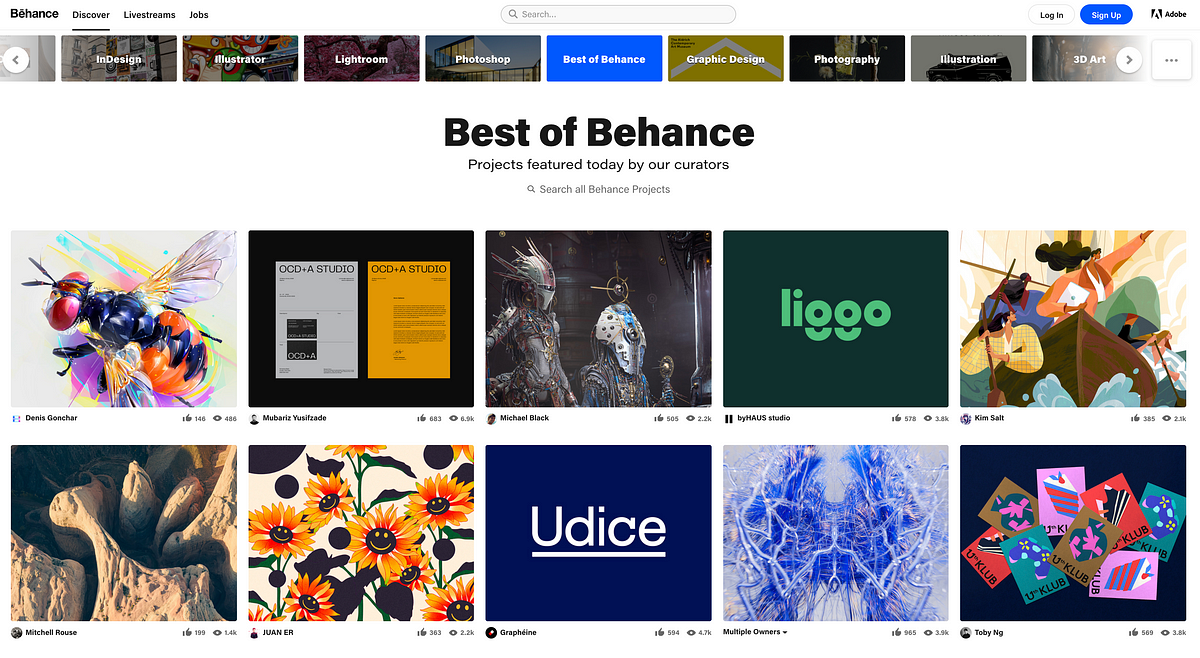Getting featured on Behance can be a game-changer for your creative career. It’s not just about showcasing your work; it’s about gaining exposure and recognition from peers and potential clients alike. In this blog post, we’re going to explore some best practices that will set your projects apart and help you connect with the right audience. Let’s dive in and discover how you can elevate your presence on this dynamic platform!
Understanding Behance and Its Audience

Before you can start crafting your best work for Behance, it’s crucial to understand what the platform is all about and who’s using it. Behance is more than just a portfolio site; it’s a vibrant community where creatives across various fields come together to showcase their talent, exchange ideas, and connect professionally. Here’s a closer look at the platform and its audience:
- Diverse Creatives: Behance serves a wide range of creative disciplines, including graphic design, illustration, photography, UI/UX design, motion graphics, and more. Understanding the unique qualities of each discipline can help you tailor your projects.
- Creative Community: The users of Behance are not only seeking inspiration but also collaboration. Engaging meaningfully with other creatives by commenting on their work or sharing project insights can help build lasting connections.
- Industry Professionals: Many professionals from various industries browse Behance looking for fresh talent. Having your work recognized on this platform can lead to job offers, freelance opportunities, and networking.
- Feedback-Oriented: The community on Behance values constructive feedback. When presenting your projects, keep in mind that others are looking for insights and critiques just as much as showcasing beautiful work.
In summary, understanding the platform and its audience will empower you to tailor your projects effectively. A keen awareness of who you’re presenting your work to is half the battle won on Behance!
Also Read This: How Behance Generates Revenue Through Its Business Model
Creating Standout Projects

When it comes to showcasing your work on Behance, the first impression is crucial. Your project should not just be a collection of images; it needs to tell a captivating story. Here are some tips to help you create standout projects that will grab the attention of viewers:
- High-Quality Visuals: Use sharp, high-resolution images that showcase your work clearly. Blurry or pixelated visuals can turn people away.
- Cohesive Aesthetic: Maintain a consistent theme or style throughout your project. This helps to present a unified vision and makes it more visually appealing.
- Compelling Narrative: Introduce your project with a strong title and description that explain the concept, process, and inspiration. This gives context to your work and engages the audience.
- Process Shots: Include behind-the-scenes images or sketches to give insight into your creative process. This not only builds interest but makes your audience feel involved.
- Organized Layout: Structure your project in a clean and easy-to-navigate format. Break your content into sections and use headers to guide viewers.
- Engagement Elements: Consider adding videos or animations if they enhance the narrative. Interactive elements can create a memorable experience.
Remember, it’s not just about showcasing what you’ve created; it’s about crafting an engaging experience that resonates with your audience. By following these practices, you’ll set your projects apart in the competitive world of Behance.
Also Read This: Grow Your Behance Profile with Effective Tips for Expanding Your Creative Network and Audience
Utilizing Keywords and Tags Effectively

If you want to gain exposure on Behance, you can’t overlook the power of keywords and tags. Effective use of these can significantly boost your project’s visibility. Let’s dive into how you can make the most out of them:
- Research Relevant Keywords: Take time to research keywords that relate directly to your work. Think about what potential viewers might search for.
- Incorporate Long-Tail Keywords: Instead of just using broad terms, include specific phrases that describe your project in detail, such as “minimalist graphic design portfolio.”
- Use the Right Tags: Behance allows you to add tags that categorize your project. Choose tags that are not only relevant but also popular within your niche.
- Avoid Overloading: While it may be tempting to use as many tags as possible, focus on quality over quantity. Stick to around 5-10 relevant tags for optimal results.
- Analyze Successful Projects: Check out the most popular projects in your category to see what tags and keywords the creators are using. This can provide a good benchmark.
- Update Regularly: As trends change, so should your keywords and tags. Regularly revisiting and updating your projects can keep them relevant.
By strategically leveraging keywords and tags, you can make your work more discoverable and increase your chances of being featured. It’s all about making it easier for people to find and connect with your creative genius!
Also Read This: How to Use Behance Mockups to Present Your Creative Work Professionally
5. Building a Strong Profile

Creating a standout profile on Behance is your first step toward gaining exposure and recognition in the creative community. Think of your profile as your online portfolio, and just like in any first impression, you want to make it count!
Here are some essential elements to focus on:
- Profile Picture: Choose a clear, professional image. Remember, people connect better with faces than with logos!
- Cover Image: Use a striking cover image that reflects your style and your work. This is the first thing visitors will see!
- About Section: Write a captivating bio. Share who you are, what you do, and what sets you apart in just a few sentences. Be authentic!
- Project Gallery: Populate your profile with high-quality projects that highlight your skills. Don't just display your work; tell the story behind each project. Explain your process, the challenges you faced, and how you overcame them.
- Skills and Tools: List the specific skills and tools you use. This helps potential collaborators or employers find you based on what you're proficient in.
Remember, a well-curated profile does more than showcase your work; it also invites conversation and interaction with other creatives. So take the time to refine your profile, as it's your gateway to the Behance community!
Also Read This: Shutterstock Affiliate Program: Earning Opportunities and Benefits for Promoting Shutterstock Images
6. Networking and Community Engagement
Networking and community engagement are crucial when it comes to gaining visibility on Behance. It’s not just about sharing your work; it's about connecting with others and fostering relationships that can lead to opportunities.
Here are some effective strategies to expand your network on Behance:
- Follow Fellow Creatives: Start by following artists whose work inspires you. Engaging with them can lead to reciprocation and open up avenues for collaboration.
- Comment and Appreciate: Take the time to leave thoughtful comments and appreciate others' work. This is a great way to show support and can catch people’s attention!
- Join Groups: Participate in Behance groups related to your area of expertise. It’s an excellent way to meet like-minded individuals, share insights, and even collaborate on projects.
- Attend Events: Look out for events or webinars organized by Behance or community members. Virtual meetups are a goldmine for networking and learning!
By actively engaging with the community, you not only increase the chances of your work being seen, but you also build a supportive network that can boost your creative journey. Remember, networking is a two-way street; support others, and you’ll find support in return!
Also Read This: How to Upload a GIF to Behance: Steps for Including Animated Media in Your Projects
7. Promoting Your Work Outside of Behance
Getting noticed on Behance is fantastic, but don’t stop there! Promoting your work outside of this platform can significantly boost your visibility and recognition. Here are some nifty ideas to get you started:
- Social Media Promotion: Share your projects on platforms like Instagram, Twitter, and LinkedIn. Tailor your posts to each audience. Use relevant hashtags and don’t shy away from engaging with your followers.
- Networking Events: Attend industry meetups, workshops, and conferences. Don’t just be a spectator. Dive into conversations, share your Behance link, and showcase your work to a wider audience.
- Create a Personal Website: A professional website can be your online portfolio hub. Include a link to your Behance profile, along with your contact information. This not only showcases your best work but also acts as a central place for potential clients and collaborators to find you.
- Collaborate with Other Creatives: Teaming up with other artists can amplify your reach. Through collaboration, you can tap into each other’s audiences and be introduced to new potential fans and clients.
- Blog About Your Projects: Writing about your creative process not only helps you articulate your ideas but also drives traffic. Share these posts on platforms like Medium or your own blog, and link back to your Behance work.
Remember, the goal is to create a consistent approach to sharing your work across multiple channels. This way, when people stumble upon your projects, they’ll recognize your name and talent!
Also Read This: Discover Open Source AI Art Generation Tools
8. Analyzing Successful Projects
If you want to get featured on Behance, it pays to study the successful projects that have already captured attention. Analyzing these can give you insights into what works and what doesn’t. Here’s a step-by-step breakdown of how to dissect these projects:
- Identify Top Projects: Start by browsing through the “Most Appreciated” section on Behance. Look for projects that resonate with you in terms of style, theme, and execution.
- Evaluate Presentation: Take a close look at how these projects are presented. Focus on the layout, color schemes, and overall aesthetics. Notice how the artist has structured their images and whether they include behind-the-scenes shots.
- Examine Descriptions: Read through the project descriptions. Successful creators often provide detailed insights into their process. Look at how they succinctly convey their story and what techniques they used.
- Assess Engagement: Check the comments and interactions on these projects. This can give you clues on what audiences appreciate or find intriguing about the work.
- Note Trends: Are there any consistent themes or styles appearing in popular projects? Is there a particular color or method that seems to stand out? Recognizing these trends can help you tailor your submissions.
By consistently analyzing these successful projects, you can refine your approach, identify gaps in your work, and ensure that you create pieces that resonate with the Behance community and beyond. Happy dissecting!
How to Get Featured in Behance: Best Practices for Gaining Exposure and Recognition
Behance is a powerful platform for creative professionals to showcase their work and connect with like-minded individuals. Being featured on Behance can significantly enhance your visibility and recognition within the creative community. Here are some best practices to increase your chances of being featured:
1. Optimize Your Profile
Your Behance profile is your digital portfolio. Ensure that it reflects your personal brand by:
- Using a professional profile picture that conveys your personality.
- Writing a compelling bio that highlights your skills and creative vision.
- Including relevant tags and links to your website or social media.
2. Create High-Quality Projects
Quality often outweighs quantity. Focus on developing a few exceptional projects rather than many mediocre ones. Consider the following:
- Aesthetic Quality: Use high-resolution images and maintain a consistent style.
- Detailed Description: Explain your thought process and the techniques used in each project.
- Engagement: Encourage comments and feedback from viewers.
3. Engage with the Community
Interact with other users to build your network. Here’s how you can do that:
- Appreciate others' work: Liking and commenting on other projects can foster reciprocity.
- Join groups and discussions: Participate in creative communities to share insights and gain exposure.
- Follow top creatives to stay inspired and learn from their approaches.
4. Keep Your Portfolio Updated
Regularly update your Behance portfolio with fresh projects and work-in-progress shots to keep your profile active. Consider:
- Adding a variety of works: Include different styles and mediums to showcase versatility.
- Highlighting collaborations: Share group projects or tie-ups showcasing teamwork and networking.
5. Share Your Work on Social Media
Promote your Behance projects on your social media channels to drive traffic and gain viewership. Utilize:
| Platform | Strategy |
|---|---|
| Share snippets and link to the full project. | |
| Use relevant hashtags to reach a broader audience. | |
| Post in design-related groups to tap into niche audiences. |
By employing these best practices on Behance, you significantly boost your chances of being featured, which can lead to greater exposure, networking opportunities, and recognition within the creative community.
Conclusion: Gaining exposure on Behance requires dedication to quality, active engagement with the community, and strategic self-promotion. By following the guidelines above, you can enhance your profile's visibility and elevate your chances of being featured on the platform.
 admin
admin








